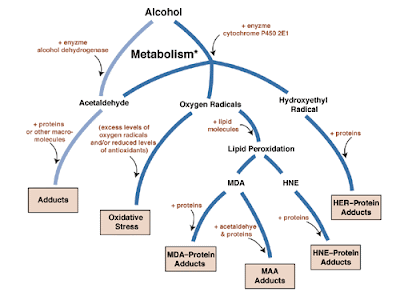 Potentially toxic products resulting from the breakdown, or metabolism, of alcohol. The major alcohol-metabolizing enzymes are alcohol dehydrogenase and cytochrome P450 2E1 (CYP2E1). Alcohol dehydrogenase converts alcohol to acetaldehyde, which can react with other proteins in the cell to generate hybrid molecules known as adducts. CYP2E1 also generates acetaldehyde, as well as highly reactive oxygen-containing molecules called oxygen radicals, including the hydroxyethyl radical (HER) molecule. Elevated levels of oxygen radicals can generate a state of oxidative stress, which through various mechanisms leads to cell damage. Oxygen radicals also can interact with fat molecules (lipids) in the cell in a process known as lipid peroxidation, resulting in reactive molecules such as malondialdehyde (MDA) and 4-hydroxy-2-nonenal (HNE). Both of these can react with proteins to form MDA-protein and HNE-protein adducts. MDA also can combine with acetaldehyde and protein to form mixed MDA-acetaldehyde-protein adducts (MAA). HER also interacts with protein to form HER-protein adducts.
Potentially toxic products resulting from the breakdown, or metabolism, of alcohol. The major alcohol-metabolizing enzymes are alcohol dehydrogenase and cytochrome P450 2E1 (CYP2E1). Alcohol dehydrogenase converts alcohol to acetaldehyde, which can react with other proteins in the cell to generate hybrid molecules known as adducts. CYP2E1 also generates acetaldehyde, as well as highly reactive oxygen-containing molecules called oxygen radicals, including the hydroxyethyl radical (HER) molecule. Elevated levels of oxygen radicals can generate a state of oxidative stress, which through various mechanisms leads to cell damage. Oxygen radicals also can interact with fat molecules (lipids) in the cell in a process known as lipid peroxidation, resulting in reactive molecules such as malondialdehyde (MDA) and 4-hydroxy-2-nonenal (HNE). Both of these can react with proteins to form MDA-protein and HNE-protein adducts. MDA also can combine with acetaldehyde and protein to form mixed MDA-acetaldehyde-protein adducts (MAA). HER also interacts with protein to form HER-protein adducts.
* Also referred to as “breakdown,” “oxidation,” and “degradation.”
Source: Tuma, D.J., and Casey, C.A. Dangerous byproducts of alcohol breakdown—Focus on adducts. Alcohol Research & Health 27(4):285–290, 2003 /http://www.niaaa.nih.gov
,












1 comment:
Potentially toxic products resulting from the breakdown, or metabolism, of alcohol. The major alcohol-metabolizing enzymes are alcohol dehydrogenase and cytochrome P450 2E1 (CYP2E1). Alcohol dehydrogenase converts alcohol to acetaldehyde, which can react with other proteins in the cell to generate hybrid molecules known as adducts. CYP2E1 also generates acetaldehyde, as well as highly reactive oxygen-containing molecules called oxygen radicals, including the hydroxyethyl radical (HER) molecule.
===========================
Thomson
Alcohol Rehab
Post a Comment